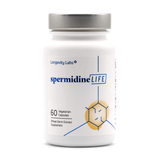
*This is a summary of the findings from various studies and articles. Further information and details on this study are located in the links below.*
Nonalcoholic fatty liver disease is one of the most common diseases in the United States. More often than not, the disease is caused by a high-fat diet and obesity, issues that run rampant across the country. Fortunately, recent research has found that spermidine can help reverse the negative effects of the disease. In this article, we will go over what fatty liver disease is, what causes it, what spermidine is, how it can help, and how you can incorporate it into your diet.
What is Fatty Liver Disease?
Nonalcoholic fatty liver disease (NAFLD) is an umbrella term for a range of liver conditions affecting people who drink little to no alcohol. The main characteristic of this disease is that too much fat is stored in the liver cells. In the United States, it is the most common form of chronic liver disease, affecting around a quarter of the population.
Those with NAFLD can develop nonalcoholic steatohepatitis (NASH), which is an aggressive form of fatty liver disease. The damage of this disease is very similar to the damage that is caused by heavy alcohol usage. Other liver diseases are often caused by excessive alcohol usage.
What Causes Fatty Liver Disease?
As of right now, experts aren’t sure as to why some people accumulate fat in the liver while others do not. Genetics are believed to play a big role but experts aren’t sure as to how large of a role. Here are some of the main causes of NAFLD and NASH:
- Overweight or obesity
- Insulin resistance which causes your cells do not take sugar in response to the hormone insulin
- High blood sugar
- High levels of fats, particularly triglycerides in the blood
Some of the things that greatly increase your chances of developing NAFLD include high cholesterol, high levels of triglycerides, metabolic syndrome, obesity, sleep apnea, type 2 diabetes, and an underactive thyroid.
Signs of a Fatty Liver
Unfortunately, NAFLD usually causes no signs and symptoms, which makes the disease so dangerous. When it does show symptoms, it can cause fatigue and pain or discomfort in the upper right abdomen. NASH, however, does show signs more frequently. Here are some of the signs:
- Abdominal swelling
- Enlarged blood vessels
- Enlarged spleen
- Red palms
- Yellowing of the skin and eyes
If you notice any of these signs, it’s best to speak with your doctor. Your doctor will be able to provide an accurate diagnosis while suggesting the treatment options that best work for you.
What Is Spermidine
Spermidine is a polyamine compound found in ribosomes and living tissues that has numerous health benefits. This polyamine can be found in many different types of foods and can also be obtained via supplements. It is a precursor to other polyamines, such as spermine and its structural isomer thermospermine.
Spermidine is a longevity agent in mammals due to various mechanisms of action, which are just beginning to be understood. Autophagy is the main mechanism at the molecular level, but evidence has been found for other mechanisms, including inflammation reduction, lipid metabolism, and regulation of cell growth, proliferation, and death.
Spermidine and the Fatty Liver
It’s important to note that research regarding spermidine and the impact that it has on the liver is still in its infancy. With that being said, recent studies have found that spermidine can help those with NAFLD. One study looked at the impact spermidine had on obese mice with NAFLD.
In the experiment, two mouse groups were kept on a high-fat diet leading to obesity and
“NAFLD liver”; one group was additionally fed spermidine.
The study found that the group with the added spermidine uptake had a healthier liver than the other group. On top of that, even with the constant high-fat diet, the group with the added spermidine intake saw increased weight reduction. The sugar (glucose tolerance) and insulin (insulin sensitivity) values, which usually become poor as a result of a high-fat diet and can thus lead to secondary diseases such as type II diabetes, were also improved by the administration of spermidine.
What this study was able to show is that spermidine interferes with the regulation of the liver’s lipid metabolism. This means it can reverse the imbalance caused by a high-fat diet. Essentially, regeneration of the liver can be improved by the addition of spermidine in liver transplant models and in diets.
What Foods Are High in Spermidine?
Spermine, which is a derivation of spermidine caused by spermine synthase, is normally found in millimolar concentrations in the nucleus. It functions directly as a free radical scavenger and forms a variety of adducts that prevent oxidative damage to DNA. The spermine synthase process is very important in the autophagy process. Here are some examples of foods high in spermidine:
- Potatoes
- Peas
- Soybeans
- Chicken
- Lentil soup
These foods will help replenish your body’s spermidine pool.
Supplements Can Help
It can be difficult to reach your recommended daily intake of spermidine simply by just consuming it in your diet. That’s why spermidine capsules and other supplements can help you do all you can to induce autophagy and reduce the unwanted effects of aging. spermidineLIFE® offers spermidine-rich capsules designed to promote cellular renewal.
We highly recommend taking your daily dose of spermidine supplements at the same time every day, preferably after you eat dinner. This makes it easy to remember to take your capsules so that you never miss a daily dose. These capsules are designed to promote autophagy, which gives your cells the ability to regenerate and rejuvenate.







